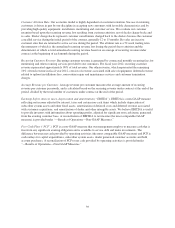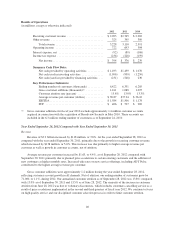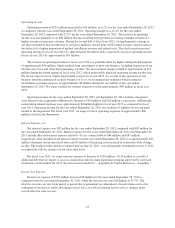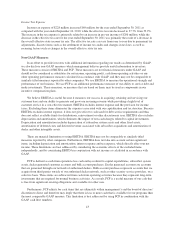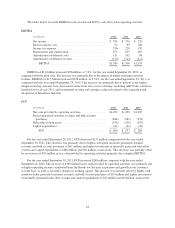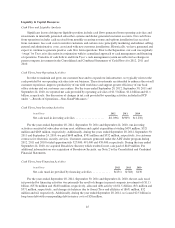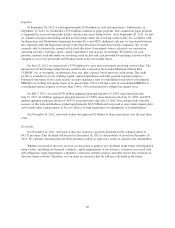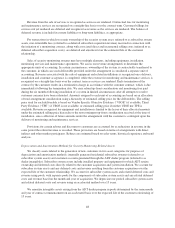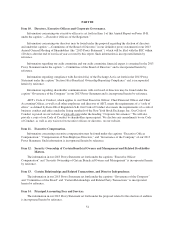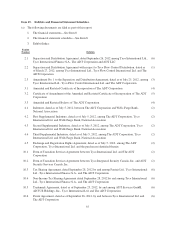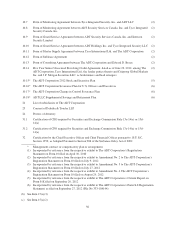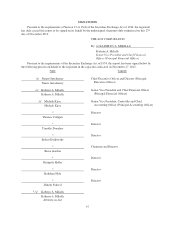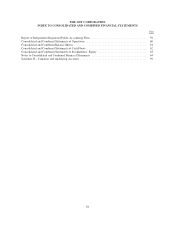ADT 2012 Annual Report Download - page 141
Download and view the complete annual report
Please find page 141 of the 2012 ADT annual report below. You can navigate through the pages in the report by either clicking on the pages listed below, or by using the keyword search tool below to find specific information within the annual report.Loss Contingencies
We record accruals for various contingencies including legal proceedings and other claims that arise in the
normal course of business. The accruals are based on judgment, the probability of losses and, where applicable,
the consideration of opinions of internal and/or external legal counsel and actuarially determined estimates. We
record an accrual when a loss is deemed probable to occur and is reasonably estimable. Additionally, we record
insurance recovery receivables from third-party insurers when recovery has been determined to be probable.
Acquisitions
We account for acquired businesses using the purchase method of accounting. Under the purchase method,
our Consolidated and Combined Financial Statements reflect the operations of an acquired business starting from
the completion of the acquisition. In addition, the assets acquired and liabilities assumed must be recorded at the
date of acquisition at their respective estimated fair values, with any excess of the purchase price over the
estimated fair values of the net assets acquired recorded as goodwill.
Significant judgment is required in estimating the fair value of intangible assets and in assigning their
respective useful lives. Accordingly, we typically obtain the assistance of third-party valuation specialists for
significant items. The fair value estimates are based on available historical information and on future
expectations and assumptions deemed reasonable by management, but are inherently uncertain.
Goodwill and Indefinite-Lived Intangible Asset Impairments
We assess goodwill and indefinite-lived intangible assets for impairment annually and more frequently if
events or changes in business circumstances indicate that it is more likely than not that the carrying value of a
reporting unit exceeds its fair value. In performing these assessments, management relies on various factors,
including operating results, business plans, economic projections, anticipated future cash flows and other market
data.
We recorded no goodwill impairments in conjunction with our annual goodwill impairment assessment
performed during the fourth quarter of fiscal year 2012. While historical performance and current expectations
have resulted in fair values of goodwill in excess of carrying values, if our assumptions are not realized, it is
possible that in the future an impairment charge may need to be recorded. However, it is not possible at this time
to determine whether an impairment charge would result or if such a charge would be material. We will continue
to monitor the recoverability of our goodwill.
Fair value determinations require considerable judgment and are sensitive to changes in underlying
assumptions and factors. As a result, there can be no assurance that the estimates and assumptions made for
purposes of the annual goodwill impairment test will prove to be accurate predictions of the future. Examples of
events or circumstances that could reasonably be expected to negatively affect the underlying key assumptions
and ultimately impact the estimated fair value of the business may include such items as follows: a prolonged
downturn in the business environment (i.e. sales volumes and prices); an economic recovery that significantly
differs from our assumptions in timing or degree; volatility in equity and debt markets resulting in higher
discount rates; and unexpected regulatory changes.
Long-Lived Assets
We review asset groups held and used by us, including property and equipment and amortizable intangible
assets, for impairment whenever events or changes in business circumstances indicate that the carrying amount of
the asset group may not be fully recoverable. If an impairment is determined to exist, we calculate any related
impairment loss based on fair value.
49


